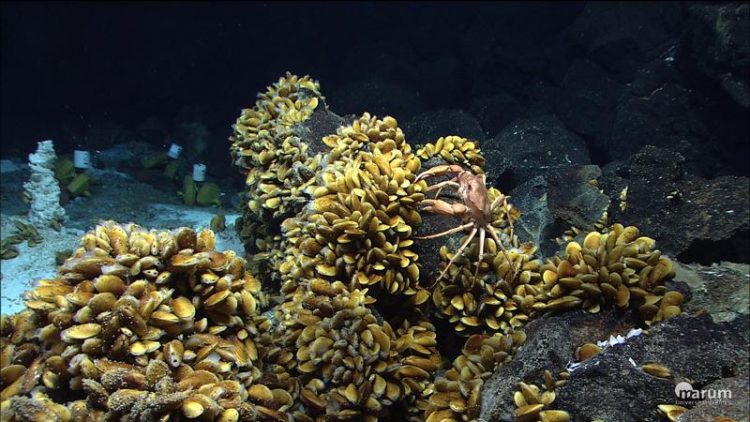Many cooks don't spoil the broth: Manifold symbionts prepare their host for any eventuality

Bathymodiolus-mussels and other inhabitants of hydrothermal vents at the Mid-Atlantic Ridge off the coast of the Azores. MARUM – Center for Marine Environmental Sciences, University of Bremen
Hydrothermal vents in the deep sea are fascinating and rich habitats. Mussels, for example, thrive in this seemingly hostile environment, nourished by symbiotic bacteria inside their gills. These bacteria, called chemosynthetic symbionts, convert chemicals from the vents that animals cannot use into tasty food for their mussel hosts.
The mussel bundles up an all-round carefree package, a German-Austrian research team around Rebecca Ansorge and Nicole Dubilier from the Max-Planck-Institute for Marine Microbiology in Bremen and Jillian Petersen from the University of Vienna now reports in Nature Microbiology.
On several research expeditions Ansorge and her colleagues visited black smokers – towering chimneys where hot, mineral-rich water gushes out of the seafloor – and collected Bathymodiolus mussels, a distant relative of the edible blue mussel. Back in the Bremen and Vienna labs they analyzed the genomes of the bacteria inhabiting these mussels in great detail. So far it was assumed that the mussel is home to only one or two types of symbionts. However, Bathymodiolus is clearly more hospitable. “In fact, we found up to 16 different bacterial strains in a single mussel,” says Ansorge.
Diversity matters
The different bacterial strains ensure that the mussel is prepared for all eventualities. They fulfill different functions, help with different metabolic conversions and have different abilities. “Different symbionts can, for example, use different substances and energy sources from the surrounding water to feed the mussel,” explains Ansorge. Others are particularly resistant to viruses or parasites.
“We think that the great diversity of its tenants makes the mussel highly versatile,” continues Jillian Petersen, leader of the University of Vienna lab involved in the study. If its environment changes – which happens frequently in such dynamic habitats as hydrothermal vents – the mussel can adapt quickly. Those bacterial strains that are particularly well adapted to the new conditions can then become more numerous. Moreover, if the mussels want to colonize new habitats, they are well prepared with this mosaic of symbionts. Obviously, the many cooks do not spoil the mussel's broth, but can actually prepare just the right broth for every occasion.
“This variety of symbionts does not fit with current evolutionary theories, according to which organisms as similar as these bacterial symbionts cannot coexist,” explains Nicole Dubilier, project leader of the study and director at the Max Planck Institute for Marine Microbiology.
This is possible due to a special feature of this symbiosis: The mussel does not feed its tenants directly, but instead ensures that they always have access to their food source at the black smokers. The symbionts obtain their food from the surrounding water. “This allows the mussel to accommodate cooks who may not be working optimally under the current conditions. You never know when they will be useful.”
From Lucky Strike to Lilliput
Lucky Strike, Semenov, Wideawake, Clueless, Lilliput – these are the names of the hydrothermal fields where Ansorge and her colleagues have so far found the hospitable deep-sea mussels. These fields are distributed along the entire Mid-Atlantic Ridge, from the Azores to far into the South Atlantic, several thousand meters under the surface of the ocean. At every location the researchers found the same pattern of unexpectedly high symbiont diversity, with minor differences in their abilities, which may be tuned to the local conditions.
“Next, we want to investigate whether this diversity also exists in other deep-sea symbioses, for example in sponges or clams,” says Ansorge. “We also want to examine if our observations are typical for symbioses or if they also occur in closely related free-living bacteria, which are very common in the oceans.” The researchers are expecting to find that their results are no exception, and that such a large variety of bacterial symbionts is common in other comparable systems. This would mean that we need to revise our current evolutionary theories about symbiotic relationships.
Dr. Rebecca Ansorge
Max Planck Institute for Marine Microbiology, Bremen, Germany
Phone: +49 421 2028-904
E-Mail: ransorge@mpi-bremen.de
Prof. Dr. Nicole Dubilier
Max Planck Institute for Marine Microbiology, Bremen, Germany
Phone: +49 421 2028-932
E-Mail: ndubilie@mpi-bremen.de
Ass. Prof. Dr. Jillian Petersen
University of Vienna
Phone: +43 1 4277 91206
Email: petersen@microbial-ecology.net
Dr. Fanni Aspetsberger
Press Officer
Max Planck Institute for Marine Microbiology,
Bremen, Germany
Phone: +49 421 2028-947
E-Mail: faspetsb@mpi-bremen.de
Rebecca Ansorge, Stefano Romano, Lizbeth Sayavedra, Miguel Ángel González Porras, Anne Kupczok, Halina E. Tegetmeyer, Nicole Dubilier, Jillian Petersen: Functional diversity enables multiple symbiont strains to coexist in deep-sea mussels. Nature Microbiology. DOI: 10.1038/s41564-019-0572-9
Media Contact
All latest news from the category: Life Sciences and Chemistry
Articles and reports from the Life Sciences and chemistry area deal with applied and basic research into modern biology, chemistry and human medicine.
Valuable information can be found on a range of life sciences fields including bacteriology, biochemistry, bionics, bioinformatics, biophysics, biotechnology, genetics, geobotany, human biology, marine biology, microbiology, molecular biology, cellular biology, zoology, bioinorganic chemistry, microchemistry and environmental chemistry.
Newest articles

First-of-its-kind study uses remote sensing to monitor plastic debris in rivers and lakes
Remote sensing creates a cost-effective solution to monitoring plastic pollution. A first-of-its-kind study from researchers at the University of Minnesota Twin Cities shows how remote sensing can help monitor and…

Laser-based artificial neuron mimics nerve cell functions at lightning speed
With a processing speed a billion times faster than nature, chip-based laser neuron could help advance AI tasks such as pattern recognition and sequence prediction. Researchers have developed a laser-based…

Optimising the processing of plastic waste
Just one look in the yellow bin reveals a colourful jumble of different types of plastic. However, the purer and more uniform plastic waste is, the easier it is to…



